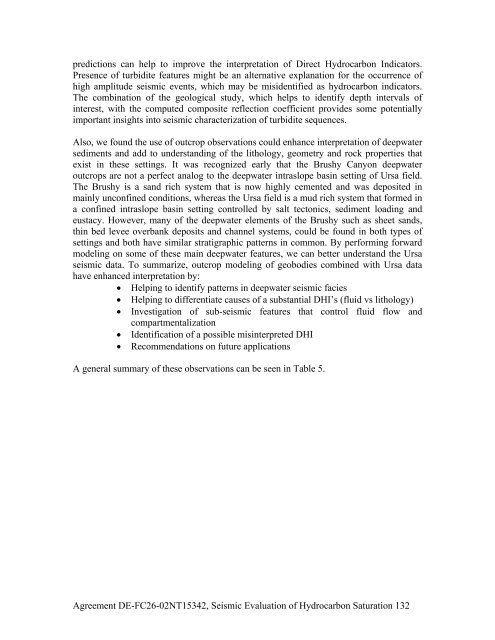Agreement DE-FC26-02NT15342, Seismic Evaluation of ...
Agreement DE-FC26-02NT15342, Seismic Evaluation of ...
Agreement DE-FC26-02NT15342, Seismic Evaluation of ...
You also want an ePaper? Increase the reach of your titles
YUMPU automatically turns print PDFs into web optimized ePapers that Google loves.
predictions can help to improve the interpretation <strong>of</strong> Direct Hydrocarbon Indicators.<br />
Presence <strong>of</strong> turbidite features might be an alternative explanation for the occurrence <strong>of</strong><br />
high amplitude seismic events, which may be misidentified as hydrocarbon indicators.<br />
The combination <strong>of</strong> the geological study, which helps to identify depth intervals <strong>of</strong><br />
interest, with the computed composite reflection coefficient provides some potentially<br />
important insights into seismic characterization <strong>of</strong> turbidite sequences.<br />
Also, we found the use <strong>of</strong> outcrop observations could enhance interpretation <strong>of</strong> deepwater<br />
sediments and add to understanding <strong>of</strong> the lithology, geometry and rock properties that<br />
exist in these settings. It was recognized early that the Brushy Canyon deepwater<br />
outcrops are not a perfect analog to the deepwater intraslope basin setting <strong>of</strong> Ursa field.<br />
The Brushy is a sand rich system that is now highly cemented and was deposited in<br />
mainly unconfined conditions, whereas the Ursa field is a mud rich system that formed in<br />
a confined intraslope basin setting controlled by salt tectonics, sediment loading and<br />
eustacy. However, many <strong>of</strong> the deepwater elements <strong>of</strong> the Brushy such as sheet sands,<br />
thin bed levee overbank deposits and channel systems, could be found in both types <strong>of</strong><br />
settings and both have similar stratigraphic patterns in common. By performing forward<br />
modeling on some <strong>of</strong> these main deepwater features, we can better understand the Ursa<br />
seismic data. To summarize, outcrop modeling <strong>of</strong> geobodies combined with Ursa data<br />
have enhanced interpretation by:<br />
• Helping to identify patterns in deepwater seismic facies<br />
• Helping to differentiate causes <strong>of</strong> a substantial DHI’s (fluid vs lithology)<br />
• Investigation <strong>of</strong> sub-seismic features that control fluid flow and<br />
compartmentalization<br />
• Identification <strong>of</strong> a possible misinterpreted DHI<br />
• Recommendations on future applications<br />
A general summary <strong>of</strong> these observations can be seen in Table 5.<br />
<strong>Agreement</strong> <strong>DE</strong>-<strong>FC26</strong>-<strong>02NT15342</strong>, <strong>Seismic</strong> <strong>Evaluation</strong> <strong>of</strong> Hydrocarbon Saturation 132
















